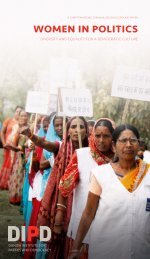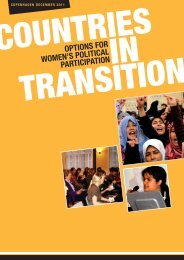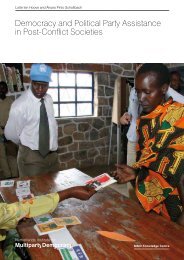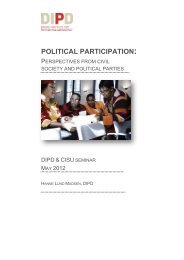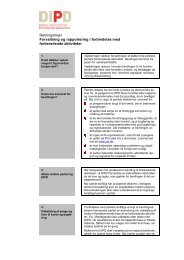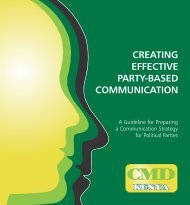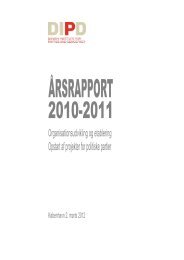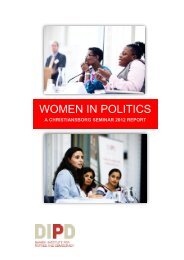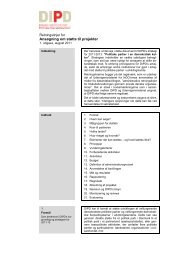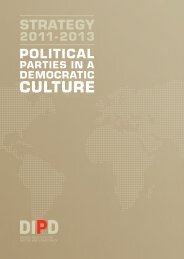Political Parties in Africa: Challenges for Sustained Multiparty
Political Parties in Africa: Challenges for Sustained Multiparty
Political Parties in Africa: Challenges for Sustained Multiparty
You also want an ePaper? Increase the reach of your titles
YUMPU automatically turns print PDFs into web optimized ePapers that Google loves.
<strong>Political</strong> <strong>Parties</strong> <strong>in</strong> <strong>Africa</strong>: <strong>Challenges</strong> <strong>for</strong> Susta<strong>in</strong>ed <strong>Multiparty</strong> Democracy<br />
Third, the Pan-<strong>Africa</strong>n Parliament has no legislative powers. It is role is consultative<br />
and advisory on policy agendas put <strong>for</strong>ward by the heads of states and the Council<br />
of M<strong>in</strong>isters. It is an <strong>in</strong>stitution without teeth, and will have little effect, if any, on<br />
the ability of the AU, let alone the member states, to tackle the challenges of the 21st<br />
century which give birth to the AU and the PAP as a sign of a significant shift from<br />
the authoritarian manner <strong>in</strong> which the cont<strong>in</strong>ent’s affairs are conducted to the age of<br />
democracy, good governance, human rights and the rule of law.<br />
4.6.2 The East <strong>Africa</strong>n Legislative Assembly (EALA)<br />
The East <strong>Africa</strong>n Legislative Assembly (EALA) is best described as the re<strong>in</strong>carnation<br />
of the East <strong>Africa</strong>n Community, established between Kenya, Tanzania and Uganda<br />
and disbanded <strong>in</strong> 1977. The treaty on the establishment of the East <strong>Africa</strong>n<br />
Community (EAC) was signed on 1999, with the ma<strong>in</strong> objective ‘to develop<br />
policies and programmes aimed at widen<strong>in</strong>g and deepen<strong>in</strong>g co-operation among<br />
the three partner states <strong>in</strong> political, economic, social and cultural fields, research<br />
and technology, defence, security and legal and judicial affairs, <strong>for</strong> their mutual<br />
benefit’ (article 5.1). Furthermore, ‘The Community will have a Customs Union,<br />
a Common Market and a Monetary Union as transitional stages, and ultimately, a<br />
political Federation of the three states’ (article 5.2). The EAC is set to establish various<br />
organs and <strong>in</strong>stitutions—the Summit, the Council, the Co-ord<strong>in</strong>ation Committee,<br />
Sectoral Committees, the East <strong>Africa</strong>n Court of Justice, the East <strong>Africa</strong>n Legislative<br />
Assembly and the Secretariat (article 9.1).<br />
This section <strong>in</strong>troduces the EALA and its relationship to political parties, and<br />
exam<strong>in</strong>es whether it has succeeded <strong>in</strong> creat<strong>in</strong>g pan-East <strong>Africa</strong>n party-to-party<br />
partnerships.<br />
The EALA was <strong>in</strong>augurated together with the East <strong>Africa</strong>n Court of Justice <strong>in</strong><br />
Arusha, Tanzania, on 29 November 2001. It consists of 27 elected members (n<strong>in</strong>e<br />
from each country), three ex officio members (the three national m<strong>in</strong>isters responsible<br />
<strong>for</strong> regional cooperation), and the secretary general of the EAC Council. Unlike<br />
the European Union, where population size is taken <strong>in</strong>to account, the EALA gives<br />
equal representation to each country regardless of population size. However, the<br />
three countries make equal f<strong>in</strong>ancial contributions <strong>for</strong> the runn<strong>in</strong>g of the Assembly’s<br />
affairs and programmes (which is not the case <strong>in</strong> the EU). In common with the<br />
Pan-<strong>Africa</strong>n Parliament, the EALA is subservient to the executive (i.e. the Council<br />
and the Summit) who hold the real power over the runn<strong>in</strong>g of the EAC’s affairs;<br />
moreover, the 27 parliamentarians represent only token representation and cannot<br />
reflect the diversity of the countries they represent, let alone the whole East <strong>Africa</strong>n<br />
sub-region.



